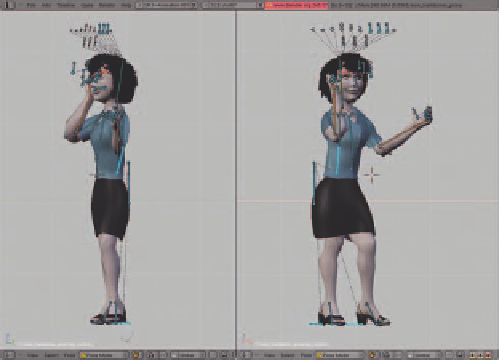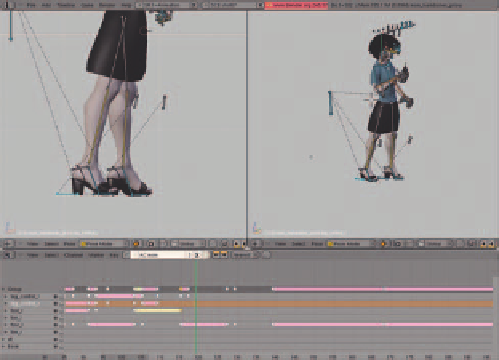Graphics Reference
In-Depth Information
With the feet locked to the rest of the body, you create the motion of the torso. When walking about, the
torso really does lead the legs, so taking care of it fi rst makes sense. For the arms, you can ignore the standard
opposing swing that develops while walking, only setting keys for them if they have some kind of deliberate
motion like a wave or a reach. You'll create the opposing swing after you key the legs.
If it helps, you can focus a camera view so that only the upper body is seen. That will help you to evaluate
how the legless walk looks. Don't forget to show your main torso bone's path to really smooth and fi ne tune
the motion.
When you have the body motion worked out,
return to the beginning of the animation.
Remove the
Child Of
constraints on the foot
controls to release the legs and feet. Now that
the body has been properly keyed and timed,
you step through the walk a frame at a time,
keying the feet and legs in a straight ahead
fashion. Before you begin, though, you should
alter the initial foot pose so that the feet strad-
dle the center line of the torso, aligned with
the starting direction of the walk. You should
also drop the torso a little bit. Figure 11.44
shows such an initial pose.
Using the right arrow key, advance the frame
counter until the back leg straightens and
“pops” or separates due to overextension of the
IK chain (Figure 11.45). This means you have
gone too far. Go back two frames and set a key
on the bone that lifts the heel off the ground.
Advance two frames, lift the heel (rotate the foot
bone, not the main leg controller), and set a key.
The IK pop should be gone, but the leg will be
close to fully extended (Figure 11.46). On that
same frame, set a LocRot key for the main foot
controller.
Figure 11.44
A good way to start the feet
Keep advancing the frame until the torso is
directly over the front leg. Don't worry that
the rear leg is beyond its reach and has begun
to stretch or poorly deform. If you've worked
with stationary walk cycles before, this will be
the “passing” part of the walk. Bring the rear leg up beside the front leg, raised from the ground (Figure
11.47). Also, clear the rotation from the foot bone that had been used to raise the heel and set a Rotation key.
Figure 11.45
The rear leg past its IK chain limit


Search WWH ::

Custom Search